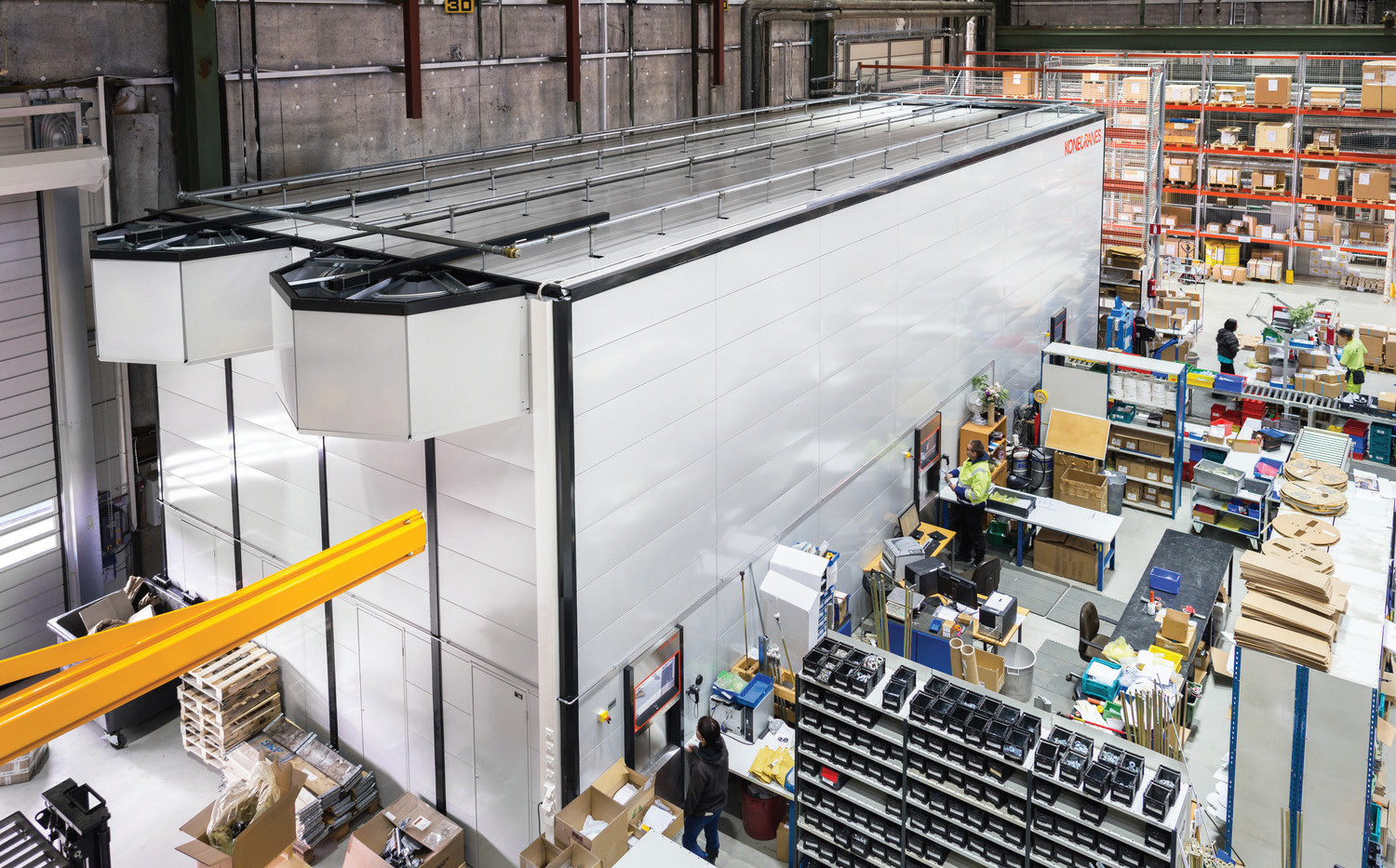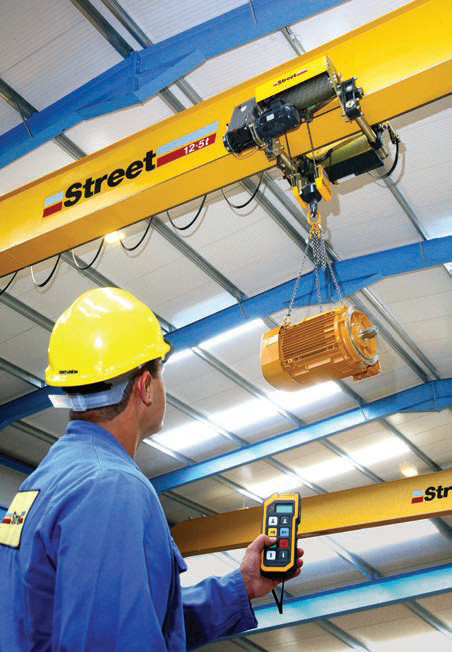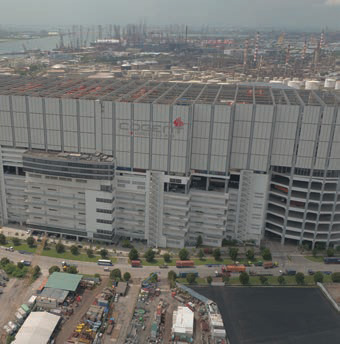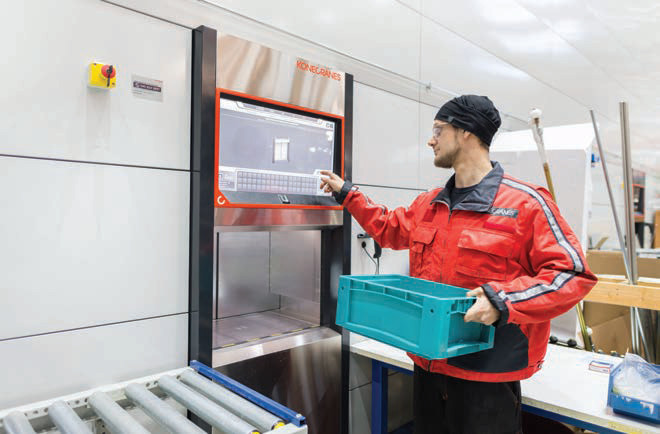Through the roof
8 August 2019Digitalisation in hoist technology has brought us such things as antisway mechanisms, load monitoring, automatic speed control, and zone control. But as Julian Champkin reports, that is just the start.
At the heart of digitalisation is data—its gathering, storage and analysis, in sometimes vast quantities. Thus, for example, the SMC multicontroller from Stahl records the complete operating data of a hoist, and can transmit it wirelessly to a global server so that it can be accessed from anywhere in the world in real time. The remaining service life of the hoist can be calculated, taking loads, speeds and running times into account. Efficient preventative maintenance can be scheduled, reducing unplanned downtime. Everything about that hoist can be known, and known from anywhere.
Only a decade ago all that would have seemed fantasy. It is now standard and routine. But if digitalisation has brought us on a rapid journey, hold on to your seats. You have seen nothing yet.
We are, it seems, on the very edge of transformation. The next stage in digitalisation is not just control of a hoist, or even of all the hoists in a plant or factory together.
To begin then, at the current state of the art. Consider process cranes, which carry out the same repetitive task many hundreds or thousands of time. That is easy to automate. A sensor switch to tell when the trolley is at the end of the runway, a relay or two to then open the grab, and your load of raw material is dumped in the right place and the trolley can return, automatically, to where it came from for the next load. Add more relays as required to give more functions.
“There used to be a lot of relays in overhead cranes,” says Chris Russell, technical director of Street Crane. “Most cranes now have a PLC on board. The most basic system on a product has sensors on the crane that activate warning lights, and the operator obeys them. So for zoning control you have infra-red sensors measuring distances, or for greater distances, you would use ultrasonic sensors.
“A lot of microprocessor controls are being built-in to hoists, but they are not yet universal. Many operators, in harsh or remote environments, want reliability and real ease of maintenance rather than sophistication. Customers in Northern Canada or the Middle East want plug-in units that do not need an expert to repair them. Users in high temperatures also, such as foundries, are wary of relying on microprocessors.
“But as sensors and processors become more reliable and less costly that is changing. For example, anti-sway is a standard in all manufacturers’ arsenals now. So is inverter control for trolley travel; but it is not yet standard for the hoisting drum. One reason for that is the size of the inverters, but they are shrinking. Within the next five years inverters in hoisting mechanisms will be standard across all manufacturers and if you want one without it will cost you more, because it will be non-standard and you will have lost the economies of scale.
“There is more and more safety monitoring of crane equipment using digital technology. An example is digital rope inspection. At present, equipment is carried around by specialists who come and check your wire ropes for internal flaws for you. Soon the equipment will be smaller, cheaper and fitted as standard to every hoist, and it will check the condition of your rope every time it is used and will display that data on your smart-phone. That is just a matter of time.
“But safety monitoring still relies on how good your sensors are,” he says. “You need sensors to be solidly reliable; and you also need them to be cost-effective in the market-place. A lot of futuristic things are possible. At present, they all cost, but are available if the customer wants it. But the marketplace is moving at a fair pace. People are wanting more, and expectations and standards are creeping up.”
Stefan Elspass is in charge of product management at Demag. For him, the modern era has its roots around the year 2015. “That was when we began to start communicating to audiences, explaining what Industry 4.0 could do,” he says.
That was just four years back. “Since then, we have been able to communicate the abstract possibilities. What we need now is to make real products and real business models.”
Key to this, he says, is the availability of technical enablers: not only the sensors themselves but the ability to communicate wirelessly, seamlessly and reliably one with another, the ability to feed data to remote monitoring, and to allow decentralised control. “Control systems have not been strong enough for the long term,” he says. But the tipping point has come. “Now is the time that Industry 3.0 is changing to Industry 4.0.”
The difference, he says, is that before, under Industry 3.0, machines were under individual central control—that is, the crane was controlled by the crane operator or by some digital system whose job and whose focus was centred around that crane. “Industry 4.0 is about decentralised control,” he says. The crane or hoist is just one part of a system of dozens, perhaps hundreds, of other machines, every one of them able to communicate with the others, all operating collectively, and all focussed on a common end.
Demag, he says, was in at the beginning of this. “We produced the first computercontrolled hoist in 2003. That was a big change in the market. We came in then with embedded controls, that could give such things as speed control. Our Safecontrol system has some decentralised aspects. The hardware drive is in a central crane cabinet that can communicate with several different cranes; it is a first step, but decentralised control means much more that this: it is the intercompatibility of the system with different kinds of hardware from different manufacturers and suppliers.
“In the past we lived in our own crane world with its own control system. Now we must make sure that our systems are enabled to operate with other machines of other kinds from other suppliers.” As a simple example, a gantry crane may be fed or may feed its load to a forklift truck. Crane and forklift need to work together; they need to talk.
“For that to happen, it needs wireless communication as a reliable, safe and capable core competence,” he says. “That means communication interfaces that are standardised right across industry.” There is such a protocol: it is called OPC Unified Architecture, or OPC UA. “Adoption of OPC UA is a precondition before Industry 4.0 can happen,” says Elspass. When every hoist maker, every forklift maker, every maker of every other machine used in a factory adopts it, the entire plant becomes, in effect, a single unit.
It will be, of course, an unbelievably complex unit—but it must be easy for the customer to use. If that seems an impossibility, Elspass has an example that shows it is not. “Consider a tablet, an iPad. It is a hugely complicated piece of hardware, but it is easily useable by almost anyone. Furthermore, it is almost infinitely flexible. Each user will use it differently, depending on what he wants and on what apps he has loaded. Similarly, the customer in Industry 4.0 can easily get exactly what he wants, just by changing the programming. The hardware will become far less important than the software.”
Elspass lists four requirements for Industry 4.0 to come to full fruition. “You need decentralisation of control; you need reliable sensors; you need a solution for reliable mass communication of 100 or more devices; and you need the Cloud as the brain and storage-place of all this information.” All these are either here or on the verge of being here. The short-term hurdle, he says, is a low-cost modem that is able to talk in a secure and reliable way. “Nearly all process cranes already have modems, though standard cranes do not. But it will come very soon. Our understanding is that prices will come down by 30–40% even in the next few months. When it does so, we shall incorporate them in virtually all our products.”
And that means that all the parts of the jigsaw will be available. It remains only to put them together—and that will happen very soon indeed.
“Now that we have all these enablers in our hands we are deciding which of our R&D activities we should transfer to real products,” says Elspass. “That is the most critical part, and also the most difficult. In my opinion, most manufacturers will fail here. You need to find the advantages to the customer; you must make it easy for him or her to use, and not scare people by its complexity. We are just one step away from that. In the next few months we intend to show our approach to selected customers. So it is a process which has started. We are on the verge of that big transformation from theory to sellable product.”
Tapani Tilus is a vice president at Konecranes. His view of the future is every bit as radical as that of Elspass. “Digitalisation is not about automation. It is about information,” he says. “That is where the future lies.
“Traditionally Konecranes has been a lifting service. Today we are selling an information service to our customers.”
Such information services began, as we have seen, a few years ago with data on crane performance, collected by sensors and transmitted wirelessly to the crane manufacturer, who stored it for analytics, instant help with breakdowns, and predictive maintenance suggestions. Konecranes’ Agilon system is taking the concept further—much further.
“People used to buy an automation system for a warehouse, or for a crane,” says Tilus. Agilon combines the two. It collects data on the item that it is lifting— and also on where the item came from and where it was delivered to. The result, he says, is a complete inventory service for the position and status of all the items in the plant. “You get access to a portal that tells you what you have, in the warehouse and progressing through the system; its book balance, its weight, its dimensions, and the place where it is now. We have integrated all that information for our customers. The actual hoisting, lifting the inventory item from A and carrying it to B, is just a part of that.”
Things that customers need to move in their factories range from assemblies weighing hundreds of tonnes to a handful of bolts that weigh just a few grams. Heavy items have traditionally been moved by overhead hoist; small items have traditionally been pushed in a cart, or put on a conveyor belt, or carried by hand. From the customer’s point of view the difference between floor-based and roof-based transport is not fundamental: all he or she wants is for the items that started here to end up there.
“So why should we not help them with the smaller goods also? We can move a small cardboard box with half a dozen washers in it. We do not have to lift. It does not have to be suspended from the ceiling. We can slide it along a stainless steel chute or a conveyor belt. We have scales built into the access points; their weights will tell you how many of the bolts or screws or widgets have been taken from the warehouse and are in the box moving through the system.”
So Agilon takes data from ground-based transport—conveyor belts, chutes, robot pallet-trolleys—as well as from overhead hoists and gantries. When an operative takes a bolt from the box, or a component from a line, the system knows and records it; when it is put back having been polished or ground or otherwise worked upon Agilon moves it on to the next process. The information is displayed and managed on a screen; the customer knows where the goods are at any time.
“And any data on the screen can be stored in the supply chain. Whenever an item leaves the Agilon system the stock record is adjusted and the system can tell the warehouse manager or send a re-order email direct to the supplier. Information from all the machines that are connected to the system is stored by Konecranes,” says Tilus, echoing the connectivity theme of Elspass’s thinking. “We are managing the data on our computers, and providing access to the supplier as well. We used to be about lifting masses. Now we are about information management and intelligent material flow.
“Knowing what you have is becoming an asset in good customer service. When you have the capabilities of data and software that is the sort of thing you can do. There is more to the hoist business than just lifting masses.”


